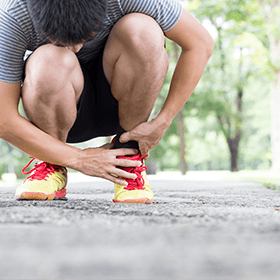By Ben Fletcher
4 Exercises to Improve Your Balance
Balance training allows your body to quickly find stable postures when it is pushed out of position. If you think about your day-to-day life, you spend a lot of time on one leg when walking. If you are involved in running-based sports, the demands upon a single leg are much greater as you are required to run at high speeds, rapidly decelerate, jump and land. However, if you struggle to control your body on one leg, these tasks become much more difficult with a greater overall risk of injury. Balance is also a great way to identify imbalances you may have as it challenges your coordination and motor control. It also requires ankle, knee and hip strength to remain in the correct position.
If you are new to balance training, standing on one leg may be a good place to start but it is important to progress the exercises as you improve. If you have recently suffered an ankle sprain, I would recommend that you seek the advice of a medical professional such as a physiotherapist before you begin your rehabilitation programme. In addition, to reduce the chances of a re-injury, staying on top of your balance training is key. If you train regularly, including some form of balance training into your warm-ups is a great way to do this.
Improve your balance with these exercises
There are a wide range of balance exercises for you to pick from with many of them requiring little or no equipment to perform. Here are four examples to get you started.
Single leg balance
- Simply stand on one leg and hold this position.
- Keep your hips and shoulders level (i.e. don't let your hip fall out).
- Keep your hips and shoulders square (i.e. don't rotate your hips and trunk).
- Once you have mastered this, you can start to introduce some movement to make the exercise more difficult, for example a knee drive or putting your arms above your head.
Single leg balance with eyes closed
- Stand on one leg, close your eyes and hold this position – it's surprising how much more difficult standing on one leg becomes when you close your eyes.
- Again, you want to keep your hips and shoulders level (i.e. don't let your hip fall out), and keep your hips and shoulders square (i.e. don't rotate your hips and trunk).
- Once you have mastered this, you can start to introduce some movement to make the exercise more difficult, for example a knee drive or putting your arms above your head.
Kettlebell pass-round
- Stand on one leg and pass a kettlebell (or something similar) around your body.
- Keep your hips and shoulders level (i.e. don't let your hip fall out).
- Keep your hips and shoulders square (i.e. don't rotate your hips and trunk).
- To make this more difficult you can increase the weight or add some movement for example passing the kettlebell under your leg and then around your waist.
Medicine ball throw and catch
- Stand on one leg and, with a partner, throw and catch a medicine ball with the aim of maintaining your balance.
- To make the exercise more difficult, you can make the catch more challenging, for example, throwing the ball high, low or to the side.
Our recommendations
In conclusion, we recommend that the first steps towards dealing with your ankle injury should be to meet with a medical professional and have your ankle assessed so you have a proper diagnosis for your pain. The professional in question can then help you with the rehabilitation of your ankle by creating an individualised rehabilitation programme. Please note that the above information is not intended to be medical advice tailored specifically for you.

